
Schloss Aigen is a castle located in Aigen, a quarter of Salzburg, Salzburgerland, Austria. The structure also includes a church, a restaurant, and a park. [1]

Schloss Aigen is a castle located in Aigen, a quarter of Salzburg, Salzburgerland, Austria. The structure also includes a church, a restaurant, and a park. [1]
The castle was built in 1402. The park was an English style park made in 1780.
During the Hungarian Revolution, in 1956, some of the refugees were processed through Salzburg. Schloß Aigen was rented by the U.S. Consulate in Salzburg and became apartments for the State Department staff.

Herrenchiemsee is a complex of royal buildings on Herreninsel, the largest island in the Chiemsee lake, in southern Bavaria, Germany. Together with the neighbouring isle of Frauenchiemsee and the uninhabited Krautinsel, it forms the municipality of Chiemsee, located about 60 kilometres (37 mi) southeast of Munich.

Hohenwerfen Castle is a medieval rock castle, situated at an altitude of 623 metres (2,044 ft), on a 155-metre (509 ft) rock pillar overlooking the Austrian market town of Werfen in the Salzach valley, approximately 40 kilometres (25 mi) south of Salzburg. The fortress is surrounded by the Berchtesgaden Alps and the adjacent Tennen Mountains. Hohenwerfen is a "sister" of Hohensalzburg Fortress, both built by the Archbishops of Salzburg in the 11th century.
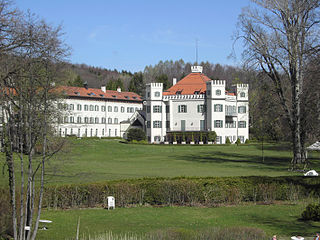
Possenhofen Castle is a condominium complex and former palace located in Possenhofen on the western shore of Lake Starnberg in Bavaria, Germany. It is best known as being the childhood summer residence of Empress Elisabeth of Austria.

Schloss Leopoldskron is a rococo palace and a national historic monument in Leopoldskron-Moos, a southern district of the city of Salzburg, Austria. The palace, and its surrounding seven hectare park, is located on the lake Leopoldskroner Weiher. The palace has been home to Salzburg Global Seminar since 1947. In 2014, the palace and the neighboring Meierhof building were opened as a privately owned hotel, Hotel Schloss Leopoldskron.

Hellbrunn Palace is an early Baroque villa of palatial size, near Morzg, a southern district of the city of Salzburg, Austria. It was built in 1613–19 by Markus Sittikus von Hohenems, Prince-Archbishop of Salzburg, and named for the "clear spring" that supplied it. Hellbrunn was only meant for use as a day residence in summer, as the Archbishop usually returned to Salzburg in the evening; therefore, there is no bedroom in Hellbrunn.

Anif Palace, also known as the Water Palace Anif, is located beside an artificial pond in Anif on the southern edge of Salzburg, Austria. The palace was once the seat of the bishops of Chiemsee, and then later was used as a court until the nineteenth century. It was remodeled between 1838 and 1848 in the neo-Gothic style. Anif is most famous for its use in several movies, including The Sound of Music, The Great Race, and Frederick Forsyth's The Odessa File.
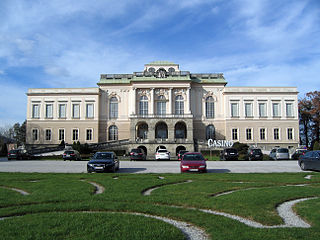
Schloss Klessheim is a Baroque palace located in Wals-Siezenheim, 4 km (2.5 mi) west of Salzburg, Austria. The palace was designed and constructed by Austrian architect Johann Bernhard Fischer von Erlach for Prince-Archbishop Johann Ernst von Thun in 1700. It became the summer residence of the Archbishops of Salzburg. Since 1993, the palace has been used by Salzburg Casino.
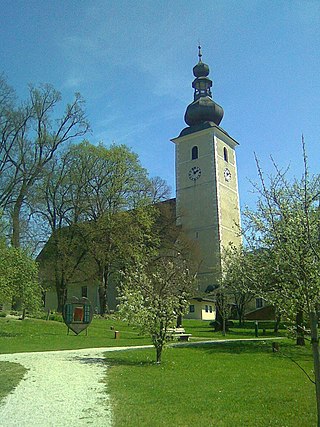
Irdning is a former municipality in the district of Liezen in the Austrian state of Styria. Since the 2015 Styria municipal structural reform, it is part of the municipality Irdning-Donnersbachtal.

The Arenberg Castle is a castle on the right bank of the river Salzach in Salzburg.

Mirabell Palace is a historic building in the city of Salzburg, Austria. The palace with its gardens is a listed cultural heritage monument and part of the Historic Centre of the City of Salzburg UNESCO World Heritage Site.
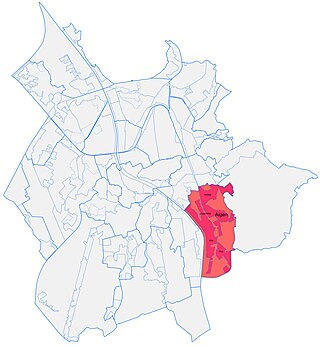
Aigen is a district in the city of Salzburg, Salzburgerland, Austria and is known as one of the most expensive residential areas of the provincial capital. It is one of the 24 districts in which Salzburg is organized. The Salzach river is its western border and the municipality of Elsbethen is to the south. Many celebrities such as the Families Porsche and Piech, Franz Beckenbauer, Renate Thyssen-Henne, DJ Ötzi and others live in Aigen.

The Petersfriedhof or St. Peter's Cemetery is – together with the burial site at Nonnberg Abbey – the oldest cemetery in the Austrian city of Salzburg, located at the foot of the Festungsberg with Hohensalzburg Castle. It is one of Salzburg's most popular tourist attractions.

The Mönchsberg, at 508 meters (1,667 ft) above sea level, is one of five mountains in the city of Salzburg in Austria. It flanks the western side of Salzburg's historic city centre, and forms part of the city's UNESCO World Heritage Site.

Hellbrunn is Landschaftsraum in Salzburg, Salzburgerland, Austria.

Finstergrün Castle is a castle in the state of Salzburg, Austria. Burg Finstergrün is 1,087 metres (3,566 ft) above sea level. The castle is believed to have been built in 1296/97 by Rudolf von Fohnsdorf. In 1300 it was described as “a border fortress” between the Archbishopric of Salzburg and the Duchy of Styria. During the 14th and 15th centuries it became the seat of the administrator who was in charge of managing the silver mines in Ramingstein. The first documented mention of the name Burg Finstergruen occurred in 1629.
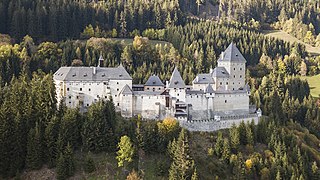
Moosham Castle is a medieval castle near Unternberg in the Lungau region of Salzburg, Austria. The spur castle is situated at a height of 1,079 metres (3,540 ft).

Schloss Seggau is a castle situated in Seggauberg in southern Styria, Austria. It is located on a wooded hill overlooking the town of Leibnitz. Schloss Seggau is at an elevation of 344 metres (1,129 ft).

The Historic Centre of the City of Salzburg, also known as the Altstadt, is a district of Salzburg, Austria, recognized as UNESCO World Heritage Site since 1996. It corresponds with the historic city center, situated on the left and right banks of the Salzach river.

Laufen Castle is a square-shaped castle overlooking the Salzach river that was built for the Archbishop of Salzburg in the 15th century. The castle is located in the town of Laufen in the German state of Bavaria. During the Second World War, it was the site of Oflag VII-C, and later of Ilag VII.

Schloss Blühnbach is a stately home in the Blühnbach valley in Werfen, Salzburg (state), Austria. Formerly, it was a hunting lodge of the Prince-Archbishops of Salzburg and Archduke Franz Ferdinand of Austria, heir to the Austro-Hungarian throne, whose assassination in Sarajevo triggered World War I. The estate is privately owned and ‘hermetically closed’ to the public.